1 Support Vector Machines
1.1 Example Dataset 1
%matplotlib inline import numpy as np import pandas as pd import matplotlib.pyplot as plt import seaborn as sb from scipy.io import loadmat from sklearn import svm
大多數(shù)SVM的庫會(huì)自動(dòng)幫你添加額外的特征X?已經(jīng)θ?,所以無需手動(dòng)添加
mat = loadmat("./data/ex6data1.mat")
print(mat.keys())
# dict_keys(["__header__", "__version__", "__globals__", "X", "y"])
X = mat["X"]
y = mat["y"]
def plotData(X, y):
plt.figure(figsize=(8,5))
plt.scatter(X[:,0], X[:,1], c=y.flatten(), cmap="rainbow")
plt.xlabel("X1")
plt.ylabel("X2")
plt.legend()
plotData(X, y)
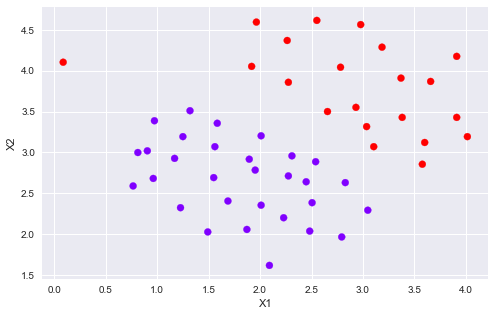
def plotBoundary(clf, X):
"""plot decision bondary"""
x_min, x_max = X[:,0].min()*1.2, X[:,0].max()*1.1
y_min, y_max = X[:,1].min()*1.1,X[:,1].max()*1.1
xx, yy = np.meshgrid(np.linspace(x_min, x_max, 500),
np.linspace(y_min, y_max, 500))
Z = clf.predict(np.c_[xx.ravel(), yy.ravel()])
Z = Z.reshape(xx.shape)
plt.contour(xx, yy, Z)
models = [svm.SVC(C, kernel="linear") for C in [1, 100]] clfs = [model.fit(X, y.ravel()) for model in models]
title = ["SVM Decision Boundary with C = {} (Example Dataset 1".format(C) for C in [1, 100]]
for model,title in zip(clfs,title):
plt.figure(figsize=(8,5))
plotData(X, y)
plotBoundary(model, X)
plt.title(title)

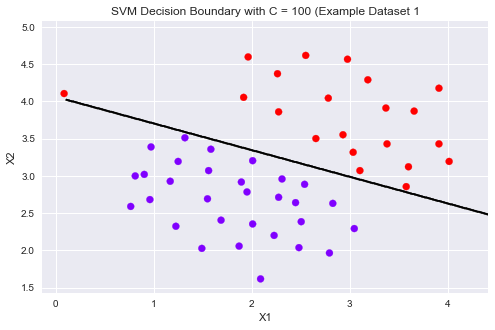
可以從上圖看到,當(dāng)C比較小時(shí)模型對(duì)誤分類的懲罰增大,比較嚴(yán)格,誤分類少,間隔比較狹窄。
當(dāng)C比較大時(shí)模型對(duì)誤分類的懲罰增大,比較寬松,允許一定的誤分類存在,間隔較大。
1.2 SVM with Gaussian Kernels
這部分,使用SVM做非線性分類。我們將使用高斯核函數(shù)。
為了用SVM找出一個(gè)非線性的決策邊界,我們首先要實(shí)現(xiàn)高斯核函數(shù)。我可以把高斯核函數(shù)想象成一個(gè)相似度函數(shù),用來測(cè)量一對(duì)樣本的距離,(x ? ? ?,y ? ? ?)

這里我們用sklearn自帶的svm中的核函數(shù)即可。
1.2.1 Gaussian Kernel
def gaussKernel(x1, x2, sigma):
return np.exp(- ((x1 - x2) ** 2).sum() / (2 * sigma ** 2))
gaussKernel(np.array([1, 2, 1]),np.array([0, 4, -1]), 2.) # 0.32465246735834974
1.2.2 Example Dataset 2
mat = loadmat("./data/ex6data2.mat")
X2 = mat["X"]
y2 = mat["y"]
plotData(X2, y2)
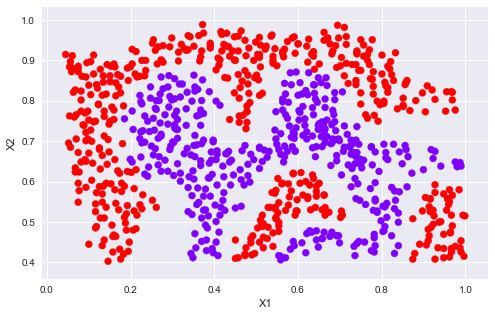
sigma = 0.1 gamma = np.power(sigma,-2.)/2 clf = svm.SVC(C=1, kernel="rbf", gamma=gamma) modle = clf.fit(X2, y2.flatten()) plotData(X2, y2) plotBoundary(modle, X2)
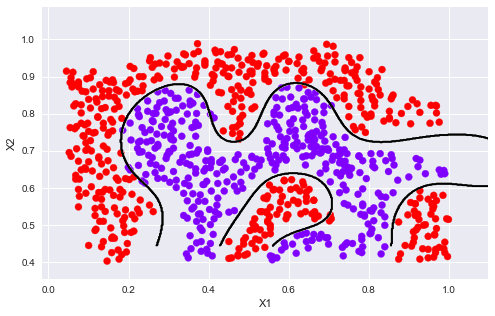
1.2.3 Example Dataset 3
mat3 = loadmat("data/ex6data3.mat")
X3, y3 = mat3["X"], mat3["y"]
Xval, yval = mat3["Xval"], mat3["yval"]
plotData(X3, y3)
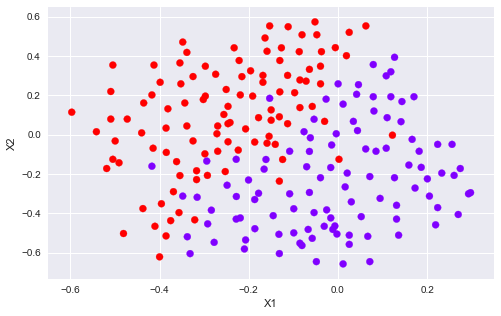
Cvalues = (0.01, 0.03, 0.1, 0.3, 1., 3., 10., 30.)
sigmavalues = Cvalues
best_pair, best_score = (0, 0), 0
for C in Cvalues:
for sigma in sigmavalues:
gamma = np.power(sigma,-2.)/2
model = svm.SVC(C=C,kernel="rbf",gamma=gamma)
model.fit(X3, y3.flatten())
this_score = model.score(Xval, yval)
if this_score > best_score:
best_score = this_score
best_pair = (C, sigma)
print("best_pair={}, best_score={}".format(best_pair, best_score))
# best_pair=(1.0, 0.1), best_score=0.965
model = svm.SVC(C=1., kernel="rbf", gamma = np.power(.1, -2.)/2) model.fit(X3, y3.flatten()) plotData(X3, y3) plotBoundary(model, X3)
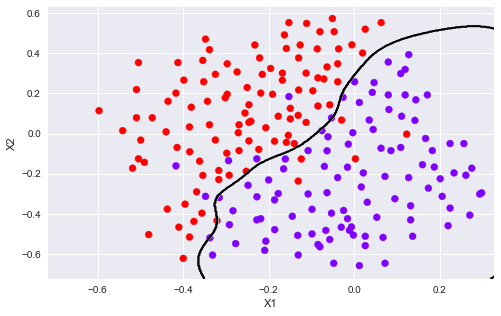
# 這我的一個(gè)練習(xí)畫圖的,和作業(yè)無關(guān),給個(gè)畫圖的參考。
import numpy as np
import matplotlib.pyplot as plt
from sklearn import svm
# we create 40 separable points
np.random.seed(0)
X = np.array([[3,3],[4,3],[1,1]])
Y = np.array([1,1,-1])
# fit the model
clf = svm.SVC(kernel="linear")
clf.fit(X, Y)
# get the separating hyperplane
w = clf.coef_[0]
a = -w[0] / w[1]
xx = np.linspace(-5, 5)
yy = a * xx - (clf.intercept_[0]) / w[1]
# plot the parallels to the separating hyperplane that pass through the
# support vectors
b = clf.support_vectors_[0]
yy_down = a * xx + (b[1] - a * b[0])
b = clf.support_vectors_[-1]
yy_up = a * xx + (b[1] - a * b[0])
# plot the line, the points, and the nearest vectors to the plane
plt.figure(figsize=(8,5))
plt.plot(xx, yy, "k-")
plt.plot(xx, yy_down, "k--")
plt.plot(xx, yy_up, "k--")
# 圈出支持向量
plt.scatter(clf.support_vectors_[:, 0], clf.support_vectors_[:, 1],
s=150, facecolors="none", edgecolors="k", linewidths=1.5)
plt.scatter(X[:, 0], X[:, 1], c=Y, cmap=plt.cm.rainbow)
plt.axis("tight")
plt.show()
print(clf.decision_function(X))
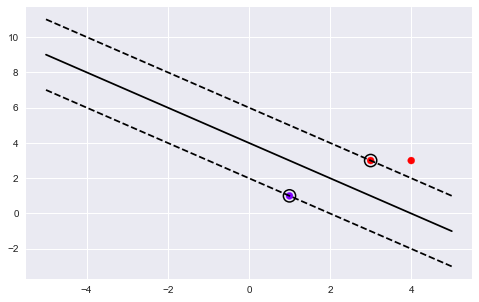
[ 1. 1.5 -1. ]
2 Spam Classification
2.1 Preprocessing Emails
這部分用SVM建立一個(gè)垃圾郵件分類器。你需要將每個(gè)email變成一個(gè)n維的特征向量,這個(gè)分類器將判斷給定一個(gè)郵件x是垃圾郵件(y=1)或不是垃圾郵件(y=0)。
take a look at examples from the dataset
with open("data/emailSample1.txt", "r") as f:
email = f.read()
print(email)
> Anyone knows how much it costs to host a web portal ? > Well, it depends on how many visitors you"re expecting. This can be anywhere from less than 10 bucks a month to a couple of $100. You should checkout http://www.rackspace.com/ or perhaps Amazon EC2 if youre running something big.. To unsubscribe yourself from this mailing list, send an email to: groupname-unsubscribe@egroups.com
可以看到,郵件內(nèi)容包含 a URL, an email address(at the end), numbers, and dollar amounts. 很多郵件都會(huì)包含這些元素,但是每封郵件的具體內(nèi)容可能會(huì)不一樣。因此,處理郵件經(jīng)常采用的方法是標(biāo)準(zhǔn)化這些數(shù)據(jù),把所有URL當(dāng)作一樣,所有數(shù)字看作一樣。
例如,我們用唯一的一個(gè)字符串‘httpaddr"來替換所有的URL,來表示郵件包含URL,而不要求具體的URL內(nèi)容。這通常會(huì)提高垃圾郵件分類器的性能,因?yàn)槔]件發(fā)送者通常會(huì)隨機(jī)化URL,因此在新的垃圾郵件中再次看到任何特定URL的幾率非常小。
我們可以做如下處理:
1. Lower-casing: 把整封郵件轉(zhuǎn)化為小寫。 2. Stripping HTML: 移除所有HTML標(biāo)簽,只保留內(nèi)容。 3. Normalizing URLs: 將所有的URL替換為字符串 “httpaddr”. 4. Normalizing Email Addresses: 所有的地址替換為 “emailaddr” 5. Normalizing Dollars: 所有dollar符號(hào)($)替換為“dollar”. 6. Normalizing Numbers: 所有數(shù)字替換為“number” 7. Word Stemming(詞干提取): 將所有單詞還原為詞源。例如,“discount”, “discounts”, “discounted” and “discounting”都替換為“discount”。 8. Removal of non-words: 移除所有非文字類型,所有的空格(tabs, newlines, spaces)調(diào)整為一個(gè)空格.
%matplotlib inline import numpy as np import matplotlib.pyplot as plt from scipy.io import loadmat from sklearn import svm import re #regular expression for e-mail processing # 這是一個(gè)可用的英文分詞算法(Porter stemmer) from stemming.porter2 import stem # 這個(gè)英文算法似乎更符合作業(yè)里面所用的代碼,與上面效果差不多 import nltk, nltk.stem.porter
def processEmail(email):
"""做除了Word Stemming和Removal of non-words的所有處理"""
email = email.lower()
email = re.sub("<[^<>]>", " ", email) # 匹配<開頭,然后所有不是< ,> 的內(nèi)容,知道>結(jié)尾,相當(dāng)于匹配<...>
email = re.sub("(http|https)://[^s]*", "httpaddr", email ) # 匹配//后面不是空白字符的內(nèi)容,遇到空白字符則停止
email = re.sub("[^s]+@[^s]+", "emailaddr", email)
email = re.sub("[$]+", "dollar", email)
email = re.sub("[d]+", "number", email)
return email
接下來就是提取詞干,以及去除非字符內(nèi)容。
def email2TokenList(email):
"""預(yù)處理數(shù)據(jù),返回一個(gè)干凈的單詞列表"""
# I"ll use the NLTK stemmer because it more accurately duplicates the
# performance of the OCTAVE implementation in the assignment
stemmer = nltk.stem.porter.PorterStemmer()
email = preProcess(email)
# 將郵件分割為單個(gè)單詞,re.split() 可以設(shè)置多種分隔符
tokens = re.split("[ @$/#.-:&*+=[]?!(){},"">\_<;\%]", email)
# 遍歷每個(gè)分割出來的內(nèi)容
tokenlist = []
for token in tokens:
# 刪除任何非字母數(shù)字的字符
token = re.sub("[^a-zA-Z0-9]", "", token);
# Use the Porter stemmer to 提取詞根
stemmed = stemmer.stem(token)
# 去除空字符串‘",里面不含任何字符
if not len(token): continue
tokenlist.append(stemmed)
return tokenlist
2.1.1 Vocabulary List(詞匯表)
在對(duì)郵件進(jìn)行預(yù)處理之后,我們有一個(gè)處理后的單詞列表。下一步是選擇我們想在分類器中使用哪些詞,我們需要去除哪些詞。
我們有一個(gè)詞匯表vocab.txt,里面存儲(chǔ)了在實(shí)際中經(jīng)常使用的單詞,共1899個(gè)。
我們要算出處理后的email中含有多少vocab.txt中的單詞,并返回在vocab.txt中的index,這就我們想要的訓(xùn)練單詞的索引。
def email2VocabIndices(email, vocab):
"""提取存在單詞的索引"""
token = email2TokenList(email)
index = [i for i in range(len(vocab)) if vocab[i] in token ]
return index
2.2 Extracting Features from Emails
def email2FeatureVector(email):
"""
將email轉(zhuǎn)化為詞向量,n是vocab的長度。存在單詞的相應(yīng)位置的值置為1,其余為0
"""
df = pd.read_table("data/vocab.txt",names=["words"])
vocab = df.as_matrix() # return array
vector = np.zeros(len(vocab)) # init vector
vocab_indices = email2VocabIndices(email, vocab) # 返回含有單詞的索引
# 將有單詞的索引置為1
for i in vocab_indices:
vector[i] = 1
return vector
vector = email2FeatureVector(email)
print("length of vector = {}
num of non-zero = {}".format(len(vector), int(vector.sum())))
length of vector = 1899
num of non-zero = 45
2.3 Training SVM for Spam Classification
讀取已經(jīng)訓(xùn)提取好的特征向量以及相應(yīng)的標(biāo)簽。分訓(xùn)練集和測(cè)試集。
# Training set
mat1 = loadmat("data/spamTrain.mat")
X, y = mat1["X"], mat1["y"]
# Test set
mat2 = scipy.io.loadmat("data/spamTest.mat")
Xtest, ytest = mat2["Xtest"], mat2["ytest"]
clf = svm.SVC(C=0.1, kernel="linear") clf.fit(X, y)
2.4 Top Predictors for Spam
predTrain = clf.score(X, y) predTest = clf.score(Xtest, ytest) predTrain, predTest
(0.99825, 0.989)
到此這篇關(guān)于機(jī)器學(xué)習(xí)SVM支持向量機(jī)的練習(xí)文章就介紹到這了,更多相關(guān)機(jī)器學(xué)習(xí)內(nèi)容請(qǐng)搜索服務(wù)器之家以前的文章或繼續(xù)瀏覽下面的相關(guān)文章,希望大家以后多多支持服務(wù)器之家!
原文鏈接:https://blog.csdn.net/Cowry5/article/details/80465922










